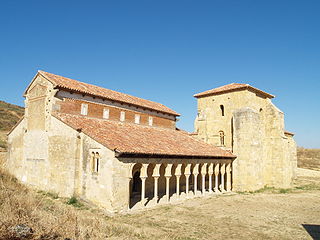 W
WThe designation arte de (la) repoblación was first proposed by José Camón Aznar in 1949 to replace the term Mozarabic as applied to certain works of architecture from the Christian kingdoms of northern Spain between the end of the 9th and beginning of the 11th centuries. Camón argued that these buildings were related stylistically to the architecture of Asturias and owed little to Andalusian styles. Moreover, since they were built by Christians living under Christian rule, neither were they Mozarabic.
 W
WThe alfiz is an architectonic adornment, consisting of a moulding, usually a rectangular panel, which encloses the outward side of an arch. It is an architectonic ornament of Etruscan origin, used in Visigothic, Asturian, Moorish, Mozarabic, Mudéjar and Isabelline Gothic architecture.
 W
WThe Hermitage of San Baudelio de Berlanga is an early 11th-century church at Caltojar in the province of Soria, Castile and León, Spain, 8 km south of Berlanga de Duero. It is an important example of Mozarabic architecture for its peculiarities, and was built in the 11th century, in what was then the frontier between Islamic and Christian lands. It is dedicated to Saint Baudilus or Baudel.
 W
WThe Church of San Lucas is located in front of the Bu hill at southeast of the city of Toledo, Castile-La Mancha, Spain. Behind a high wall, attached to the church, was located the old parish cemetery, where it is told that the last Mozarabs of the city were buried.
 W
WSan Miguel de Escalada is a monastery in the province of León, Spain, located 10 km from the Way of St. James pilgrimage route to Santiago de Compostela. The building is an example of Mozarabic art and architecture or Repoblación art and architecture.
 W
WThe Mozarabic church of Santiago de Peñalba is located in the Valle del Silencio in the region of El Bierzo, province of León, Community of Castile and León, Spain.
 W
WThe Santo Tomás de las Ollas hermitage is situated in the town with the same name close to Ponferrada, León (Spain).
 W
WThe Church of St Mary at Wamba, province of Valladolid, Spain is a medieval building dating back to the Reconquista. The eastern part of the building is of 10th century date, whereas the western part is 12th century. The church is of architectural interest and is being considered for World Heritage Site status along with nine other Mozarabic sites. It is currently on a "tentative list".